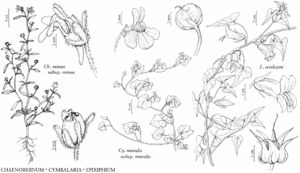Chaenorhinum
Consp. Regn. Veg., 123. 1828.
| Taxon | Illustrator ⠉ | |
|---|---|---|
 | Chaenorhinum minus subsp. minus Cymbalaria muralis subsp. muralis Epixiphium wislizeni | Yevonn Wilson-Ramsey Barbara Alongi Barbara Alongi |
Herbs, annual [perennial]. Stems erect or ascending, glandular-pubescent, sometimes glabrate. Leaves cauline, opposite proximally, alternate distally; petiole present proximally, sometimes absent distally; blade oblanceolate to lanceolate, not fleshy, not leathery, margins entire. Inflorescences axillary [terminal], flowers solitary [racemes]; bracts present. Pedicels 5–20 mm; bracteoles absent [present]. Flowers bisexual; sepals 5, proximally connate, calyx bilaterally symmetric, urceolate-spreading, lobes narrowly oblanceolate to narrowly lanceolate, glandular-pubescent; corolla white to grayish or lilac [blue, pink, pale-yellow], usually with 2 purple spots or stripes internally on palate, bilaterally symmetric, bilabiate and personate, cylindric, tube base not gibbous, spurred abaxially, lobes 5, abaxial 3, adaxial 2; stamens 4, adnate to corolla, didynamous, filaments glabrous; staminode 0 [1]; ovary 2-locular, placentation axile; stigma capitate. Fruits capsules, dehiscence poricidal. Seeds 40–60, blackish brown to brown [black, grayish], ovoid to ellipsoid, wings absent. x = 7.
Distribution
Introduced; Europe, Asia (Georgia), Asia (Turkmenistan), n Africa, also in e Asia
Discussion
Species 23 (1 in the flora).
Contrary to usual practice, de Candolle did not double the r in his spelling of Chaenorhinum; the orthography was changed in later works, including de Candolle’s own (including the 1829 reissue of the 1815 volume), as some authors thought it should be corrected (for example, D. A. Sutton 1988).
Capsule shape, wall thickness, and dehiscence; seed surface ridging; and corolla lobe margins are features used in placing Chaenorhinum species into either three sections (D. A. Sutton 1988) or three genera (F. Speta 1980). In the latter scheme, C. minus, along with nine other species, is treated as Microrrhinum (Endlicher) Fourreau. Recent molecular studies (N. Yousefi et al. 2016) demonstrated that the Chaenorhinum clade consists of two main subclades mostly corresponding to sect. Chaenorhinum and sect. Microrrhinum (including two of the recent segregate genera of Speta, Albraunia Speta and Holzneria Speta; see Speta 1982); however, C. minus probably belongs to the third, early-branching subclade, which is sister to the rest of the genus. Thus, it is better to accept Chaenorhinum in a wider sense, including Microrrhinum.
Chaenorhinum origanifolium (Linnaeus) Kosteletzky, a perennial native to southwestern Mediterranean Europe, is sometimes grown in rock gardens; it might be expected to escape locally.